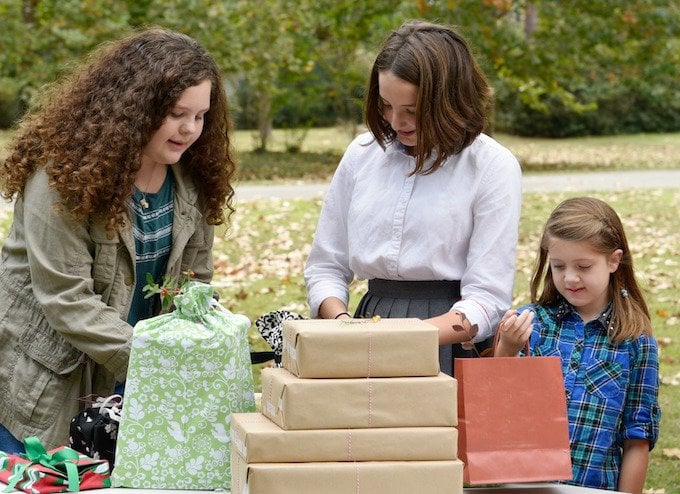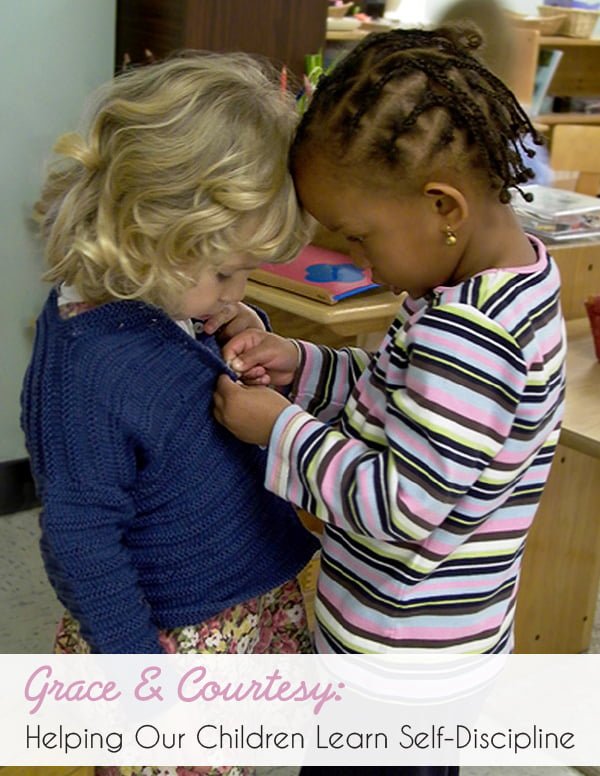Bringing Montessori Grace and Courtesy Lessons Home
The theme of Grace and Courtesy is the oil that keeps a group of people functioning smoothly. It is the ambiance parents can create in the home and the teacher can create in the Montessori classroom.
It is a general attitude of graciousness and respect. We can only create it when first we model it with our own actions, and then with good-natured lessons, we demonstrate the way we do things in our class, or in our home.
Let’s consider a few examples.
We want our children to be helpful. So how do we teach that? Be helpful, go out of your way to help a sick neighbor or a grandparent that needs some assistance.
We want our children to be respectful. How do we teach respect? Be respectful of your spouse and of your children.
The only way our children learn to behave is by observing and modeling it.
Modeling a Good Example
As parents and as teachers, we quickly learn that we cannot say one thing and do another and expect the child to do what we say. In psychology, it is called cognitive dissonance when words do not match behavior, and children notice it immediately. Ultimately, our own maturity and our own efforts to live better are what help our children learn to behave.
From an early age, even when neurologically and physically, children cannot control their own behavior, they are watching and taking in our behaviors. If we are tense and have our teeth clenched while we try to help a child calm down, they are going to feel the tension and have a harder time calming down.
Their principal emphasized logical consequences, which is the same approach we take at home. Students were encouraged to handle a disagreement among themselves before a teacher intervened.
The principal was fun and positive with the kids. He treated them with respect, and expected the same from them.
One of his disciplinary tactics surprised a few parents (especially those used to a more conventional school setting). The school pet, a gray female tabby, was an indoor / outdoor cat. She would often nap on one of the couches in the media center.
If a child was too rough with her, the principal would give a gentle warning. He’d say something like, “I don’t think she likes that. Look at how her ears are laid back (or did you hear that growl?). You should give her some space.” Occasionally, a child wouldn’t follow his suggestion and the cat would take a swipe at their hand. The principal would help but not coddle the child. He’d kindly and matter-of-factly say, “Well, now you know her warning signals. Let’s go clean this off and get a bandaid.”
I like this example because it reinforces natural consequences and teaches the child that animals are worthy of boundaries and respect, too.
Grace and Courtesy Activities
We can learn to take a deep breath when our children are having meltdowns and help them regain control. Especially when they are very little, when we help babies and toddlers calm down, they are establishing the neurological connections to self-calm. Many studies tell us that the roots of violence lie in the inability to self-calm.
What is Grace and Courtesy?
This is one of many questions about the Montessori method parents have. Grace and Courtesy includes many things, from care of the self and care of the environment to learning the kind and gracious way to handle all manner of situations. We care for one another’s needs and we help one another learn new activities.
An authentic Montessori school places importance on teaching practical, real-life skills. My sons attended a wonderful school on a 6-acre farm. They spent plenty of time outside in the garden, on the playground, kickball field, or helping tend to the chickens and sheep.
When we see our children not functioning the ways we wish, in many cases, we simply re-present the behavior that we want, without shame or blame. When children are deliberately naughty, we may need to take stronger action, help them calm down and try again.
Here is a sample list of grace and courtesy lessons many Montessori teachers use in their classrooms to establish the culture of respect for self, one another and the environment.
Feel free to take the suggestions that may be valuable for your family or your classroom and create your own list that supports your family’s values.
Classroom Management
These are some of the general lessons taught and expected in the care and running of the Montessori classroom.
- How to listen to directions
- How to get the teacher’s attention
- Place hand on teacher’s shoulder
- Wait for acknowledgement
- How to raise hand at circle time and wait to be called on
- How to wait to speak after others finish
- How to shake hands with teacher/adult
- How to ask for help from a teacher or another student
- How to greet a visitor: “Hello, my name is…. Welcome to (our home or name of school).”
- How to listen to a story or poem without shouting out questions in the middle of the story
- How to learn a song at circle time
- How to sing with a group
- How to recycle paper
Social Skills Between Adults and Children
These are skills that are taught and modeled. Most social interactions can serve as teachable moments and real-life situations for grace and courtesy.
For instance, teachers may greet students by getting on the child’s level and smiling or sharing kind words like, “Good morning” or “How are you today?”
- Friend greeting a friend
- Making an apology
- How to admit a mistake and ask to be forgiven
- How to say, “I’m sorry. I won’t do it again.
- How to give comfort to another
- Asking, “Are you all right? May I help you?”
- Getting a teacher
- How to introduce friends: “Mary, this is my friend, Tomas.”
- Asking to watch another’s lesson
- Asking to join in play
- Asking for a turn
- Asking an older child for help
- Asking permission to join or leave a group lesson
- Inviting another child to play
- How to refuse an invitation kindly
- Introducing myself to another: “Hello (or “Hi”). My name is….”
- How to say “no” politely
- “No, thank you. I don’t want to do that.”
- How to say, “Stop! Stop! You’re hurting me. Stop. I don’t like that!”
- How to ask someone to move: “Could you please move? I would like to sit here.”
- “Excuse me, please. I want to walk through here.”
Care of the Garden
Spending time in nature is part of the Montessori method. The garden offers many important lessons in real life and cause and effect.
- Watering the plants
- Pulling weeds
- Setting up a plant area
- Sweeping walkways
- Harvesting
These lessons are a start, an example of what you can do, when you set your mind to thinking about what matters in how your home or classroom is run. With these lessons we set the standard of how we want our classrooms and our homes to function. Develop the lessons you need for the layout of your school or home and the rituals you wish your children to follow.
Remember, in Montessori, we do not assume the children know something, but we teach everything, giving the child the opportunity to do thing correctly, as they generally want to do.
More Montessori at Home Resources
There are many great reasons to incorporate Montessori principals at home. Here are some resources you might find helpful.
How to Set Up a Montessori Kitchen at Home


